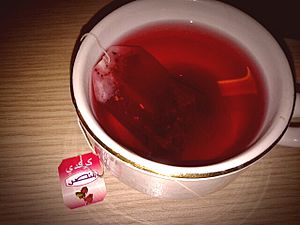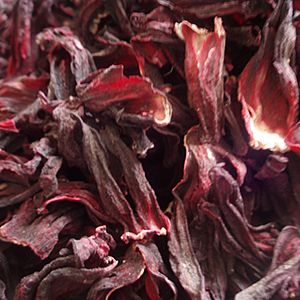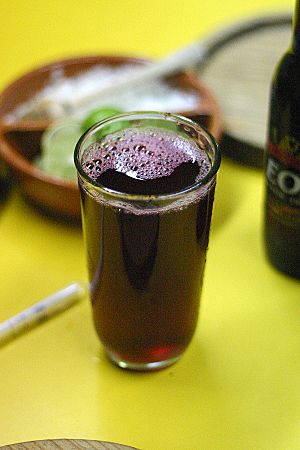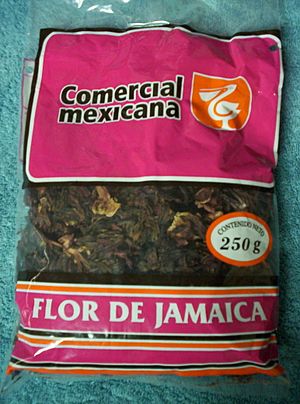Hibiscus tea facts for kids
Hibiscus tea is a yummy herbal drink. It's made from the bright red parts of the roselle flower. These parts are called calyces. The tea can be enjoyed hot or cold. It tastes a bit tart, like cranberry juice.
Contents
Where People Enjoy Hibiscus Tea
People all over the world love hibiscus tea. It's known by different names and prepared in unique ways.
Africa
The roselle plant, which gives us hibiscus tea, probably first grew in Africa. You can find dried hibiscus flowers in markets across West and East Africa.
West and Central Africa
This tea is very popular in West Africa and parts of Central Africa.
- In Senegal, it's called bissap. It's even known as the "national drink of Senegal"!
- People often add mint or ginger to their hibiscus tea in West Africa.
- In Ghana, it's known as "sobolo."
- In Nigeria, it's called "zobo."
North Africa
In some parts of North Africa, especially Egypt and Sudan, the tea is called karkadé.
- It's served hot or chilled with ice.
- At weddings in Egypt and Sudan, people traditionally toast with a glass of hibiscus tea.
- You can often find vendors selling karkadé on the streets of Cairo.
Americas
Hibiscus tea is also a favorite in the Americas.
Mexico and Central America
In Mexico, Central America, and parts of South America, it's called agua de flor de Jamaica. This means "water of Jamaica flower."
- It's one of many aguas frescas, which are refreshing drinks made from fresh fruits or plants.
- You can often find agua de Jamaica in Mexican restaurants.
- To make it, the dried calyces are steeped in boiling water. Then, the liquid is strained, and sugar is added. Sometimes, people add clove, cinnamon, or ginger.
- It's usually served cold. In Jamaica, it's a special drink for Christmas, often enjoyed with fruitcake.
Panama
In Panama, both the flower and the drink are called saril. This name comes from the English word "sorrel."
- It's made by boiling the calyces with chopped ginger, sugar, clove, cinnamon, and nutmeg.
- Panamanians traditionally drink saril around Christmas and Chinese New Year. This is similar to how it's enjoyed in the Caribbean.
Caribbean Islands
In the English-speaking Caribbean, the drink is called sorrel. It's a very important part of Christmas celebrations there.
- Some breweries even make a "Sorrel Shandy" by mixing the tea with beer.
United States
In American soul food culture, hibiscus tea is one of the "red drinks" linked to West Africa. It's often served in soul-food restaurants and at African-American gatherings.
Southeast Asia
Hibiscus tea is also popular in Southeast Asia.
Thailand
In Thailand, roselle tea is usually served cold and very sweet, poured over ice.
- You can often find plastic bags of sweetened 'grajeab' (hibiscus tea) near schools and in local markets.
- Sometimes, it's even made into a wine.
Other Countries
The drink is also enjoyed in Malaysia, Cambodia, and Indonesia.
Europe
Hibiscus tea has made its way to Europe too.
Italy
In Italy, hibiscus tea is known as carcadè or Italian tea.
- It's usually drunk hot, often with sugar and lemon juice.
- It became popular in Italy as a substitute for regular tea when the country faced trade restrictions.
Other European Countries
In other European countries, hibiscus tea is often mixed into other herbal teas. It's used to add color and flavor, especially with malva flowers or rose hips.
Research on Hibiscus Tea
Studies have looked into the health effects of hibiscus tea.
- Drinking hibiscus tea seems to help lower high blood pressure a little bit.
- Most people tolerate hibiscus tea well. It doesn't usually harm the liver or kidneys in small amounts. However, drinking very large amounts might not be good for your liver.
See also
 In Spanish: Agua de Jamaica para niños
In Spanish: Agua de Jamaica para niños





